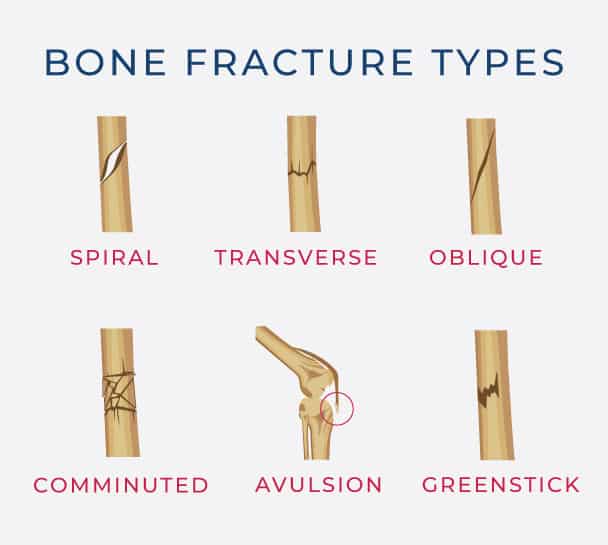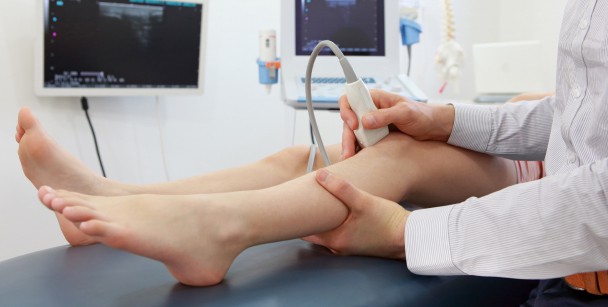
Broken bones happen for a wide variety of reasons from osteoporosis to high force impact injuries. They also vary in terms of severity, which is often determined by the location of the fracture on the body and the type of break. The most common types of fractures are compound (in which the affected bone has protruded from the skin, causing a wound) and simple (also referred to as “closed fractures,” are any fracture that doesn’t break through the skin). You need to be aware of for broken bones and when to go to the ER. These two types of breaks include several other categories:
- Spiral fractures – Caused by extreme twisting pressure on the bone, common in accidents involving machinery but also possible in sports.
- Transverse fractures – Caused by extreme perpendicular pressure to a bone.
- Oblique fractures – Caused by extreme pressure at any angle other than perpendicular to the bone and resulting in slanting breaks.
- Comminuted fractures – Refer to fractures that occurred in multiple places on the bone.
- Avulsion fractures – Caused by extreme force on a tendon or ligament, resulting in a small piece of bone-breaking away.
- Greenstick fractures – Only occur in children because of bone flexibility, resulting in partial fractures.
Most breaks that occur on an appendage such as the hand or foot can be easily treated by a trip to an urgent care center nearby, where the break will be assessed and treated based on the severity of the break. However, some fractures should be seen at the hospital first for emergency medical attention.
Is a Broken Bone an Emergency?
You can seek emergent care for any broken bone, regardless of the level of pain or visual severity of the injury. Some can be treated at an urgent care facility rather than requiring a trip to the ER for broken bones, and some of the most common breaks (fingers and toes, ankles, wrists, hands, and feet) are easily treated at urgent care. Granted, there are a few tell-tale signs that you should go to the emergency room rather than an urgent care center, the most obvious ones being:
- If there are any open wounds with a visible piece of bone protruding from the skin
- If more than one bones appear to be broken (which the injured will be able to assume if the pain is radiating from more than one area)
- If the injury took place anywhere aside from a limb or appendage, such as a rib, collarbone, neck, hip, shoulder, face, etc.
- If the injured site appears disfigured, suggesting a need for setting and/or surgical correction
If you’re at all concerned that the injury may fall into the above categories, it’s best to go ahead and go to the emergency room so that there is no delay in care or risk of worsening the injury.
Can I Go to Urgent Care for a Broken Foot?
The easy answer is “Yes, you can go to urgent care for a broken foot.” Naturally, if the injury has affected numerous bones within the foot or ankle, or if it is a compound fracture, you’ll want to bypass the urgent care center and go directly to the emergency room. However, if you were able to go to an urgent care center and they’ve determined you don’t need to go to the ER for broken bones, they may want to splint the area (if possible based on the location) and refer you to an orthopedic doctor for a boot and/or cast. They’ll also likely treat you with pain medication to alleviate the worst of your discomfort and have further recommendations for proper healing.
Can Urgent Care Facilities Do Ultrasounds?
Most urgent care facilities will also have the ability to perform ultrasounds, which can be used to determine the extent of any internal damage done by a break. It’s best to check with your nearest facility before going in to ensure they have the machinery, but both X-ray machines and ultrasounds are common for urgent care centers to have.
Fractures occur for any number of reasons and anywhere in the body. They can be incredibly mild and resolve on their own in rare cases, but they can also be life-threatening if they puncture internal organs or cause internal bleeding. If you have or suspect you may have broken a bone anywhere other than on a limb or appendage, seek emergency medical attention. At Village Emergency Centers, we’re open 24/7 to offer expert medical care for bone fractures, breaks, or and other emergencies. Find a location today or visit our website to check-in online.



